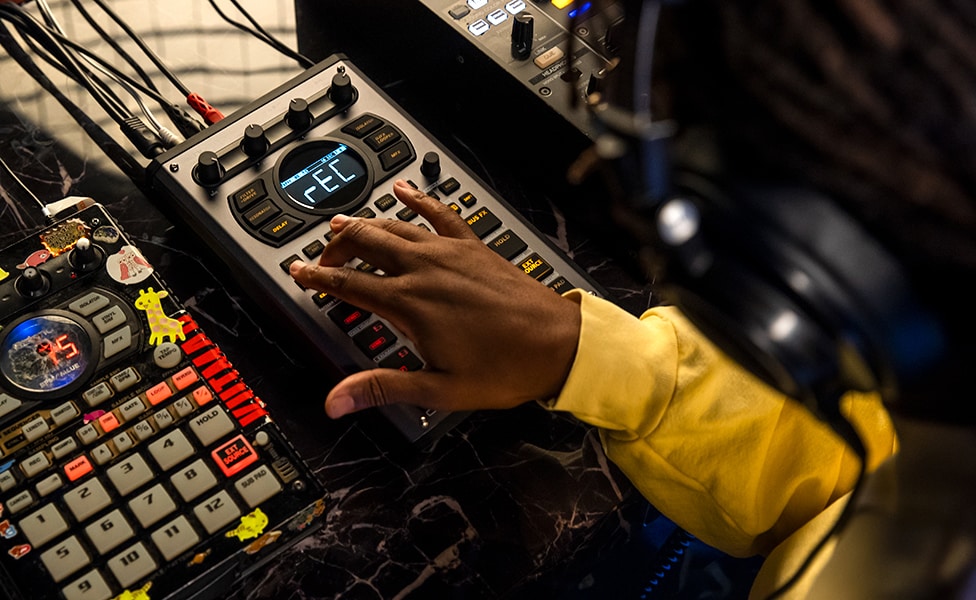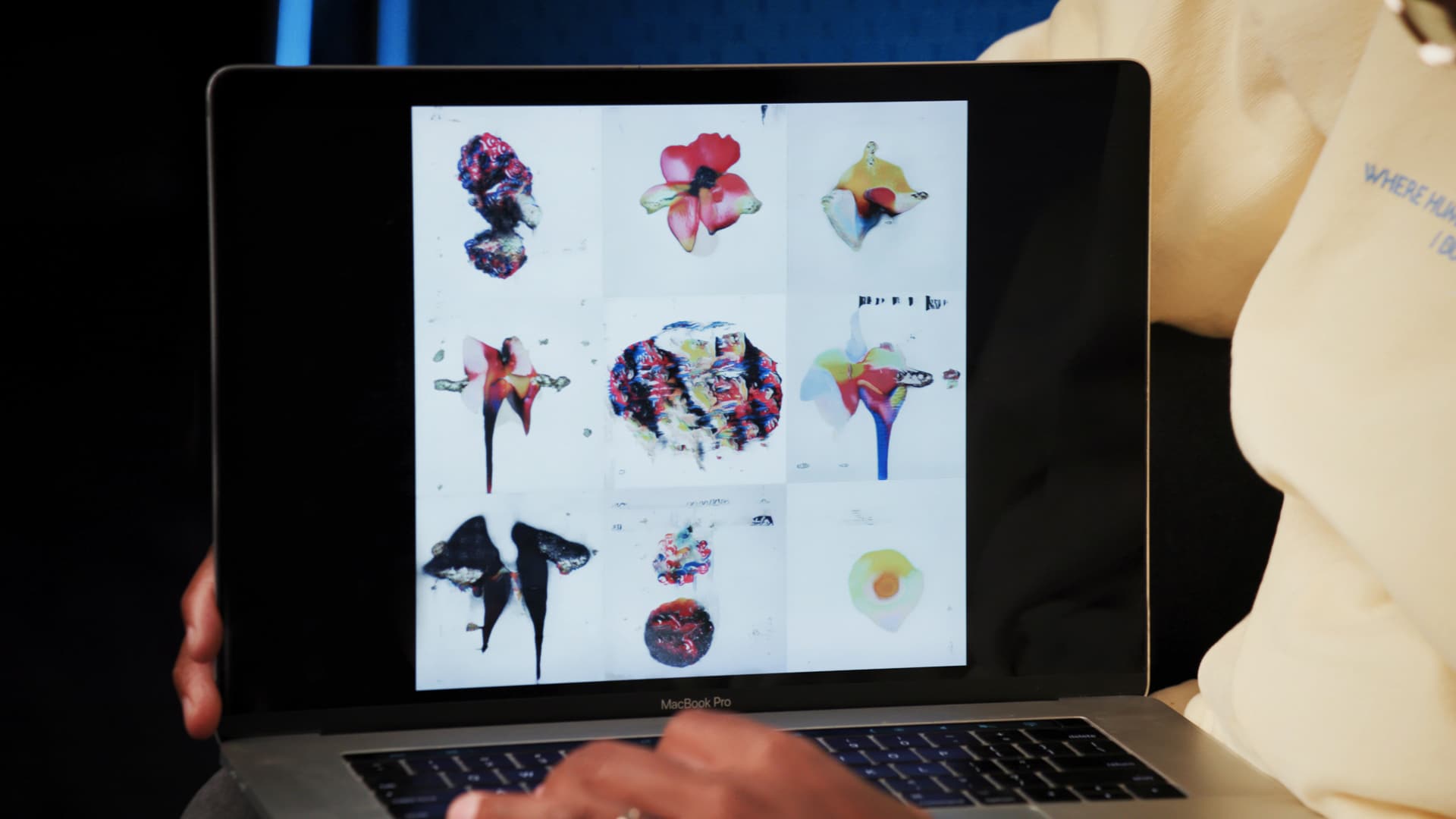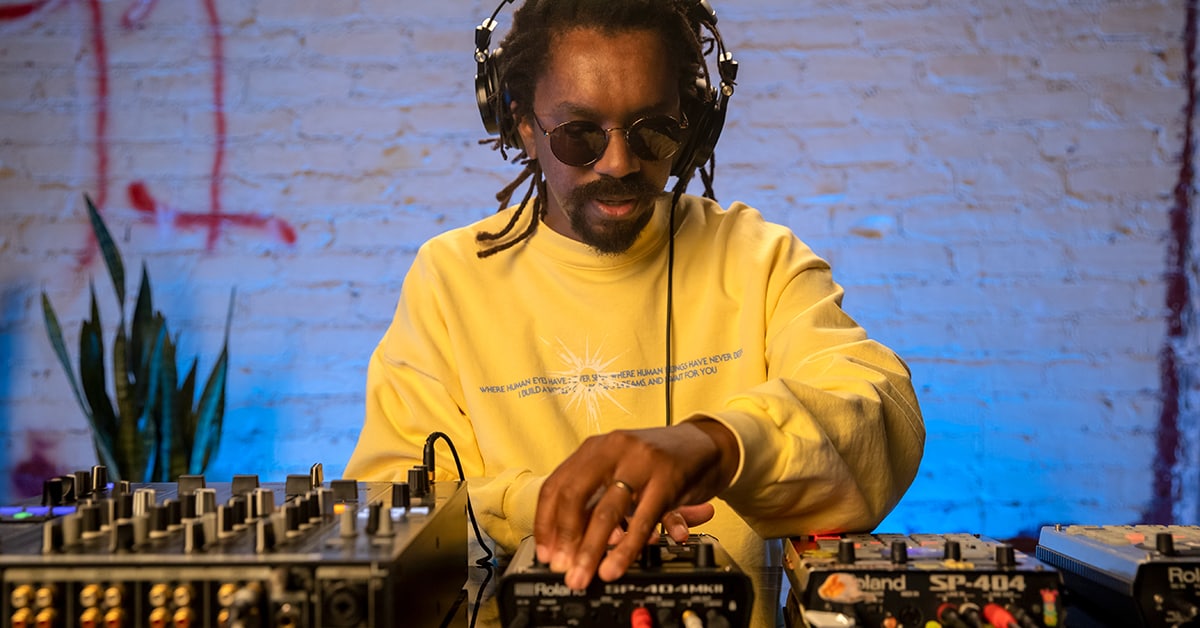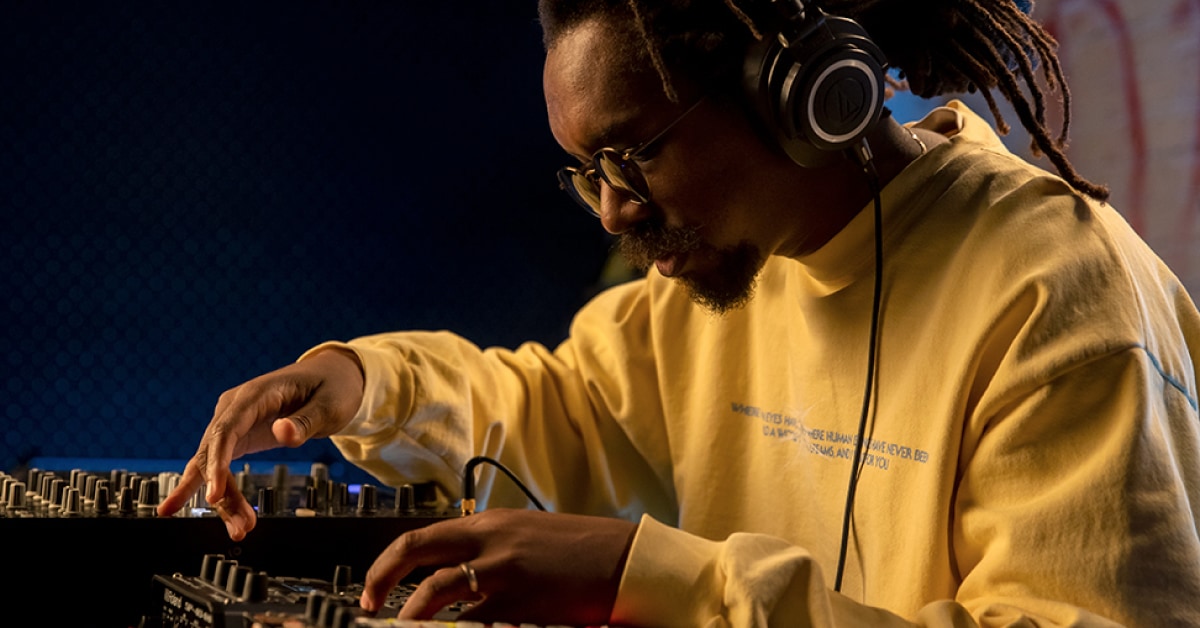Musician and painter Teebs is known for his otherworldly beats, layered soundscapes, and virtuosity with the Roland SP-404 sampler. From his initial introduction on the L.A. beat music scene to his recent exploration with AI-generative images inspired by his own artwork of painted record sleeves, Teebs’ journey has been as innovative and genre-bending as his music. In this interview, we dive into his first impressions of the new SP-404MKII model, his songwriting process on the ethereal “Mirror Memory” off his latest album Annica, and his philosophy on music’s role in fostering a community.
Can you tell us how you started painting and beatmaking, and how these two art forms interconnect for you?
Teebs: I have an older brother who was working with music, toying around with FL Studio, and I had the younger-brother attitude of needing to get involved. I would get home sooner than him, take the tapes and do what I could. I was also really into skateboarding. Most of my life was focused on that, and then I stopped. I got hurt. I was in a little wheelchair for a while, and I was like, “Maybe I can do stuff at home more often,” and that was painting and music. It was exciting—this feeling of maybe not just following in someone's footsteps, but doing something for me.
When did you first discover the Roland SP-404, and why were you drawn to its style of music-making?
The SP-404 was the first tool that I gravitated toward. I had no idea what I was doing—bought some things, regretted it instantly, and then eventually I saw the SP-404 for sale online. I was like, “Okay, this is affordable. This is uniquely small. I can understand it easily without having much prior knowledge of music.” I bought it, and I was like, “All I know is how to mess with sounds. I don't really know much about sampling, but this sounds cool.” I started messing with it and realized how easily I could translate my feelings through it, how exciting it feels when I'm reversing sounds and adding effects. A long time later, these are still the boxes I feel very comfortable around.
Where did you first start seeing the SP-404 around the L.A. music scene? Why do you think it’s become such a go-to tool?
I was dragged into L.A. through friends, discovering the excitement of sound—Low End Theory was a place that was just so interesting to us, and I didn’t know much about it. My friend was like, “You need to check this out. I'll drive you over there.” It’s like a 40-mile drive, and I went on a Wednesday. Eventually, I started playing there myself, and realizing—oh, he's also using an SP-404, and so is that guy, and Samiyam, Jonwayne, Dibia$e. I started seeing everyone using this same machine, and I didn’t really understand why. But I did know, for me, the SP-404 just made so much sense—the plug-in, the simple setup. You can easily build your vision through this machine.
Can you talk about “Mirror Memory” and the process of writing it? How did it evolve while you were working on it?
“Mirror Memory” is one of the songs from my latest release, Annica, on Brainfeeder Records. I started building it in the SP-404, as I usually do. I was going through samples, drum patterns, and eventually met my friend, Sofie Fatouretchi, who is such an incredible musician and painter. I had her play viola over a different piece of music, and eventually realized that the two made much more sense together. I took that viola, reorganized it, broke it down to simple notes and moments of her creativity, then layered and reassigned and upped the tempo of my early production, merging the two into this new song.
How did working on “Mirror Memory” influence the rest of the album?
It was one of the first beats I made during the album cycle. The rest were all just floating and half-done, but once this was completed, it changed my whole thought process and flow on what to work with and how to chop it up. Normally, I produce on FL Studio. I bring everything here first, and I get my sound set up. I make a drum pattern in the sampler, and then from there, I usually like to explore reversing sounds. Just all kinds of simple ideas and iterations, trying to understand what I want to do with the beat and how I can get a feel for it, and then take it all from there. That’s how "Mirror Memory" was made. It was a really long time, but a fun process making the drums, then working with instrumentalists and bridging the two at this new pace.
What does “Mirror Memory” mean for you? What do you associate with that music-making experience?
To me, it represents a moment. I started the production in late 2018, and the record came out in 2019. When I listen to it, I think about where I was sitting, what situations I was in at the time, and I think of Sofie's viola and where she recorded. I tend to think about the small sounds—the chair squeaking under her while she's playing. I can't hear the cars passing, but I remember what they sounded like. I'm transported to that moment. The colors of the sky—I tend to look out the window every once in a while. Those are the things that stick to me the most, and those people in that time. It's quite nice to remember that moment of collaboration, those people you're with, just living. A little snapshot of the energy.

Having spent a considerable amount of time working with the SP-404, what are your impressions of the SP-404MKII?
The first thing I noticed was that it's extremely detail-oriented. It gives you that ability to get closer to your sound, the way it lays out your sample and being able to look at your whole display. This is a production heavyweight tool, compared to its old generation. As somebody that uses this often, they’ve answered so many things people have been asking for. A lot of people see these things out in the wild, and they’re wondering what it’s all about. I think this brings that more to home. If you’re not wanting to look at a computer screen all the time, this is a solid option. You’re getting all that information in a small interface, and you don’t have to feel the drag of a computer.
How does it compare for performing in a live setting, or holding up on the road?
It offers way more to what I want to do for a live set, but it takes some things away. I think what’s taken away isn’t as important as what you gain and what this machine can do. I’m looking forward to experimenting more for that live sake.
I love the design. The buttons are much bigger, and seem a lot more supported. I usually break these things off in seconds, so this is a much safer setup. I travel with these things like crazy. And I’m shocked that you don’t have to have a gigantic card anymore—that was a whole thing of finding these camera cards for the SP, and stacking up so you could continuously change sets. Since everything is internal now, it seems like a happier place overall. You’re just here. You’re not carrying these things that, if you lose this card, everything goes down with the ship. You have this space.
Can you speak to some of the specific features? What does it offer in terms of loops or editing your samples?
With chopping, this will make it a lot cleaner. I tend to have lots of issues getting loops to be perfect. You can be off by a little bit, and you let something loop for about a minute, and you start getting this drift. This new machine has canceled that out, and that saves a ridiculous amount of time.
Also, having the ability to fine-tune your sounds when you work with samples. You’re working with a lot of loose sounds with instrumentalists, playing stuff yourself, recording live—even through the input, you get this hodgepodge of things that aren’t on the same pitch. You lose the speed, but you’re gaining that ability to fine-tune things quickly. It has a quick button that excites me, because I can deal with the loop itself later. I think matching the pitches is super important.
How does the MKII compare to the original SP-404 when handling multiple effects?
I haven’t dialed it down for myself yet, but I’m enjoying this bus—the ability to have two effects at once. The limitation of the SP-404 was one effect, that’s it. If you wanted to dance between effects, you’re having this split second of no effect, then looking for your new one, trying to be quick and fancy about it. This changes that whole game. It’s more re-planning, but you’re setting yourself up for a really beautiful environment when going out and sharing your sounds.
The cassette simulator's pretty dope. Going back and forth between that and the tape echo, you can find a really interesting sound. Or, maybe the cassette simulator and the Juno chorus, which is my personal favorite right now. It’s a whole new tool for this kind of thing.
The MKII is able to map different tempos to different beats. How do you think that will affect your performances?
That means a lot. Timing is huge. With the SP-404 lately, I use it for bringing my sounds to people, and time signatures are hectic, especially when you’re on the road. A lot of this machine is premeditative—you can’t go on stage and decide you want to quickly change time signatures if you made a mistake.
[Now] you can set things up and you can sync everything. It’s almost like getting that Ableton cheat code of putting all your sounds in the same pocket. So, you can focus on more of what you want to do.
What flexibility is offered in terms of the MKII’s ability to stream audio from your phone?
I have my Dropbox always on my phone. This gives me the ability to go anywhere. I always record demos, especially when I’m with collaborators on the phone. I want the live feeling. I want to see if that sound has something special to it, and hear it in different settings. This makes it a lot easier to experiment with it, instead of going from the phone to computer. You’re able to go straight to your machine, and listen again through the effects you love, or in a different headspace now that you’re in a workshop environment. You can edit, sample, chop, loop or do anything from that point. The phone input is pretty amazing—it adds a lot more fluidity.
You sample from all sorts of places to create these beautiful sonic textures. Can you talk about your philosophy behind building these soundscapes, and how they foster connection?
Working with lots of different sounds brings a colorful palette. I'm very into collaboration in general. So even if I'm just making music by myself, with myself, I think it speaks volumes having these different elements of noise and sound that build the environment. It speaks to many people moving forward in one direction. Tying that back into community, it's similar to the idea that you have all of these sounds—maybe from myself, collaborators, other sources—pulling together to make one song. It's a big effort, whether the people are still with us or not, or wherever these sounds come from. Whatever is happening, it's a lot of people together doing one thing.

Your latest work is an NFT collection called Record Seeds. Can you talk about your interest in digital works, how the project came about and what you see for it moving forward?
I've been really interested in digital works for a while now, and over the past year, I spent more time trying to understand this kind of work. The Record Seed Project is an NFT project of 404, with images based off of moving GANs that all come from my paintings. I paint most of my album covers, and I've done many record sleeve paintings in the past—I usually pull these from throwaway bins, ones that are water-damaged, sun-damaged, no longer usable. I usually take those sleeves and start working with the material.
Basically, it pulls out stills from those motion GANs, or even just what they call "seeds" once the machine is learning from the art. So, I have it learn over weeks, training on my work, and it starts to get to a point where it looks more reasonable. When I get to that point, I end up pulling the seeds out and saying, “Okay, these are all really cool.” I'll take these from this latent space in this computer and have these prints.
It's interesting with this token-based system that people are getting these cool pieces of art they enjoy, and from then on, we continue to stay in communication. Maybe when we start doing shows again, they will give you access to certain things, and you as an artist can hone in on people that really want to explore your world. I’m hoping to run it through the rest of next year into the next album, connecting all the dots that way.
You created 404 of these images in total. How was this project inspired by the SP-404?
We have 404 of them because that machine started everything that led to this project. Finding those record sleeves that were destroyed and battered and deciding to paint on them—that was because I was going to record stores to look for samples and music to work with on the 404, because I knew it was a sampler. I was like, “This is the coolest first place you go to. You go to the record store. You sample. You go through the process.” And as I was doing that, I just kept walking by these dirty throwaways. I started taking them home, and painting them, and enjoying that process of being at the record store—this all-encompassing place of sound and visuals, and people meeting together. I eventually built that into making paintings, and then turning them into AI-generative works of art.
You're known as a member of the L.A. beat scene. Can you talk about the community you discovered there, and how that connection was fostered by music?
The L.A. beat scene was my first time feeling like I was in a place that celebrated the exact same thing that I did. It was music I could truly understand and relate to, and I could see myself in so many different fractions of these other musicians, but in completely different ways. These are different people, different ideas—completely different trajectories, but they're here, and it's this range of sound from many backgrounds. It reminds me of skateboarding—like, this skate video came out [éS Menikmati], and there's all these guys from different parts of the world, and their music choices were so unique, but yet they're all skateboarding. It's this one thing, but it's driving all the energy together. I think when I started visiting Low End Theory, that was when I realized it’s a place where a lot of energy gathers at once.
What role does music play in forging communities? How does music unite us?
I look at music as a way to find yourself, to learn about yourself, and learn about the world through other people’s eyes. There's so much you can gain from grouping together, helping each other, feeling connected with others. Music is one of the most powerful languages we have to talk to one another, to set aside many differences and come together. It’s a tool that gives us the power to be ourselves, and gives us the power to go out and meet others.
Keep up with Teebs.
"Music travels faster than any painting could, and it's something we all recognize from the minute we're born."











